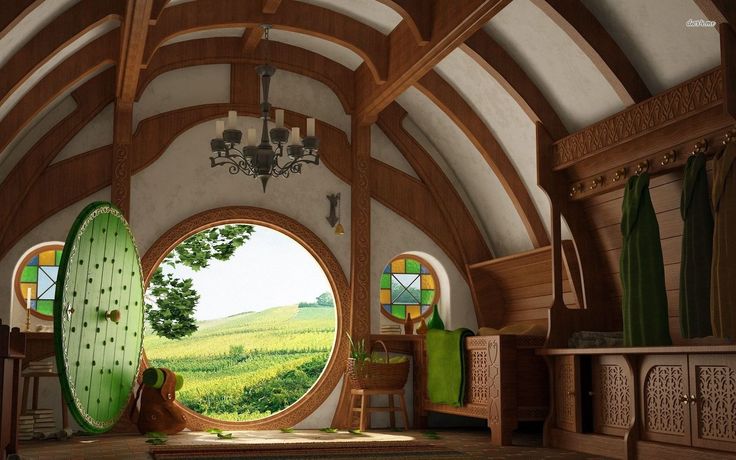What is a Hobbit Home?
A hobbit home, often recognized for its unique architectural features, is rooted in the imaginative works of British author J.R.R. Tolkien. Introduced in his seminal novels such as “The Hobbit” and “The Lord of the Rings,” these quaint dwellings belong to the hobbit community, a fictional race characterized by their love for peace, quiet, and a profound connection to nature. The design of a hobbit home is distinguished by its circular doors, small windows, and natural building materials that allow them to blend seamlessly into the surrounding landscape.
Architecturally, hobbit homes are often described as burrow-like structures, featuring rounded shapes and earthy tones that mimic the rolling hills of the Shire, where the hobbits reside. A prominent feature is the grass-covered roofs, which not only contribute to the aesthetic quality but also provide insulation and allow the homes to integrate harmoniously with the environment. The interiors are cozy, often adorned with warm colors and ample storage for provisions, reflecting the inhabitants’ agrarian lifestyle. The simplicity and functionality inherent in these designs symbolize a way of living that prioritizes sustainability and comfort.
The cultural significance of hobbit homes in Tolkien’s narratives is profound. They epitomize a lifestyle that values community, leisure, and a connection to the earth, showcasing a form of life that prioritizes simple pleasures over modern complexities. Hobbits, who often partake in gardening and enjoying meals together, may find solace in their homes, which serve as personal sanctuaries amid the natural beauty of the Shire. Their architecture not only provides physical shelter but also represents the values and traditions of hobbit culture, celebrating a harmonious relationship with nature.
The Charm of Hobbit Home Design
The charm of hobbit home design lies in its seamless blend with nature and the thoughtful incorporation of natural materials, predominantly stone and wood. This architectural style pays homage to the surrounding landscape, often built into the hillsides or nestled among trees, allowing for a rustic aesthetic that feels organic and inviting. The use of locally sourced materials not only enhances the visual appeal but also contributes to the sustainability of these whimsical structures.
Inside a hobbit home, space is optimized with cozy, functional layouts designed to maximize warmth and comfort. The interiors often feature rounded doors and windows, which not only symbolize the charm of these dwellings but also create a sense of whimsy and enchantment. Built-in furniture, such as benches and shelving, is commonly found, with many designs utilizing hidden compartments to ensure that every nook serves a purpose. This clever integration of furniture reflects a lifestyle that values simplicity and functionality, all while maintaining a delightful aesthetic.
The vibrant color schemes often seen in hobbit homes contribute significantly to their overall charm. Earthy tones mixed with splashes of brighter colors evoke a warm, inviting atmosphere. These palettes not only complement the natural surroundings but also enhance the sensory experience, making the interiors feel comfortable and welcoming. As a result, it is common for individuals drawn to cozy, eco-friendly living to seek inspiration from the timeless design of hobbit homes.
Overall, the design of hobbit homes embodies an ethos of sustainability and a harmonious relationship with nature. Modern architects and builders have increasingly looked to these enchanting structures for inspiration, incorporating elements of hobbit home design into contemporary dwelling practices aimed at promoting eco-friendly living. By marrying traditional craftsmanship with modern sensibilities, the hobbit home appeal continues to thrive and inspire.
Building Your Own Hobbit Home: A Step-by-Step Guide
Creating a hobbit home is an enchanting endeavor that invites creativity and a connection to nature. The first phase involves planning, which begins with selecting the ideal location. Look for a spot that harmonizes with the landscape, preferably in a rural setting surrounded by greenery. Ensure that the site is easily accessible while also maintaining a sense of seclusion, characteristic of a true hobbit dwelling.

Once a suitable location has been identified, the next step is to design blueprints for your hobbit home. These plans should reflect the unique features often associated with hobbit architecture, such as round doors and windows, earth-sheltered walls, and cozy interiors. Utilize software or consult with an architect to bring your vision to life, ensuring that the design is structurally sound and adheres to local building codes.
The construction phase begins with excavation, which involves digging into the hillside or ground to create a natural, earth-sheltered environment. It’s essential to carefully plan for drainage to avoid water pooling around your hobbit home. Once excavation is complete, you can focus on building the walls; natural materials such as stone, straw bales, or earth can be effective choices. These materials not only provide insulation but also blend seamlessly with the surrounding landscape.
To add charm and character, implement unique features such as a round door made from reclaimed wood and charming, asymmetrical windows. You might consider creating an interior layout that includes open spaces and nooks, maximizing the sense of coziness central to hobbit life. Sustainability is key; prioritize eco-friendly materials and construction practices, such as solar panels and rainwater collection systems, to reduce your home’s environmental impact.
Embracing these practices will not only create a picturesque and snug hobbit home but also foster a sense of stewardship for the environment. With each step thoughtfully executed, your dream of living in a quaint, earth-inspired dwelling can become a gratifying reality.
Experiencing Hobbit Homes: Visits and Attractions
The allure of hobbit homes has captivated visitors across the globe, with various attractions dedicated to offering a glimpse into this enchanting world. One of the most notable sites is Hobbiton, located in New Zealand’s Waikato region. This expansive film set, designed for the cinematic adaptations of J.R.R. Tolkien’s “The Lord of the Rings” and “The Hobbit,” provides a truly immersive experience. Guests can take guided tours through the village, exploring the intricately designed hobbit holes, the iconic green hills, and the picturesque gardens that surround them. These tours often culminate in a visit to the Green Dragon Inn, where visitors can enjoy a pint of specially crafted beverages, further enhancing the immersive experience.
Alongside Hobbiton, other attractions worldwide celebrate the spirit of hobbit homes. For instance, the “Hobbit Village” in the Aysgarth Falls area of England invites guests to explore a quaint, rustic community modeled after Tolkien’s inspirations. In Norway, you can find hillside lodges that mimic the comfortable, earthen style of hobbit abodes, offering unique accommodations for those seeking a whimsical retreat in nature. These themed lodgings often come with modern amenities, allowing guests to enjoy the comforts of home while enveloped in a breathtaking landscape reminiscent of the Shire.
Many visitors to these hobbit home attractions share similar sentiments, often expressing a sense of nostalgia and wonder as they wander through these charming environments. The combination of nature, architecture, and fantasy creates a magical atmosphere, attracting not only Tolkien enthusiasts but also those who simply appreciate unique experiences. With each site offering its own distinct charm and inspiration, exploring these hobbit home attractions provides an exciting opportunity to step into a world of whimsy and creativity, inviting all to embrace their own adventures in the delightful realm of hobbits.


